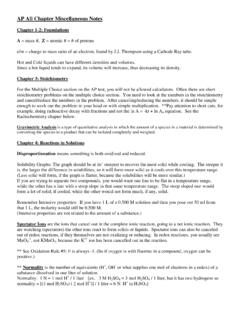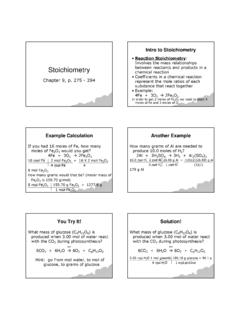Transcription of CHAPTER 3 STOICHIOMETRY OF FORMULAS AND …
1 3-1 CHAPTER 3 STOICHIOMETRY OF FORMULAS AND equations Cl amu g/mol Cl Mass Cl = (3 mol Cl) x ( g Cl/l mol Cl) = g Cl Al amu g/mol Al Mass Al = (2 mol Al) x ( g Al/l mol Al) = g Al Plan: The FORMULAS are based on the mole ratios of the constituents. Avogadro s number allows the change from moles to atoms. Solution: a) Moles of C atoms = ()12221112 mol C1 mol Sucrose1molC H O = 12 mol C b) C atoms = ()2312221112221112 mol x 10 C atoms1molC H O1molC H O1molC = x 1024 C atoms 1 mol of nitrogen could be interpreted as a mole of nitrogen atoms or a mole of nitrogen molecules. Specify which to avoid confusion. The same problem is possible with other diatomic or polyatomic molecules, , Cl2, Br2, S8, and P4.
2 For these elements, as for nitrogen, it is not clear if atoms or molecules are being discussed. The molecular mass is the sum of the atomic masses of the atoms or ions in a molecule. The molar mass is the mass of 1 mole of a chemical entity. Both will have the same numeric value for a given chemical substance but molecular mass will have the units of amu and molar mass will have the units of g/mol. The mole maintains the same mass relationship between macroscopic samples as exist between individual chemical entities. It relates the number of chemical entities (atoms, molecules, ions, electrons) to the mass. P4 molecules = ()3424434234241molCa (PO )1 mol PAvogadro's Number P g Ca (PO )Molar Mass1 mol Ca (PO )4 mol P1 mol P Plan: It is possible to relate the relative atomic masses by counting the number of atoms.
3 Solution: a) The element on the left (green) has the higher molar mass because only 5 green balls are necessary to counterbalance the mass of 6 yellow balls. Since the green ball is heavier, its atomic mass is larger, and therefore its molar mass is larger. b) The element on the left (red) has more atoms per gram. This figure requires more thought because the number of red and blue balls is unequal and their masses are unequal. If each pan contained 3 balls, then the red balls would be lighter. The presence of six red balls means that they are that much lighter. Because the red ball is lighter, more red atoms are required to make 1 gram. c) The element on the left (orange) has fewer atoms per gram. The orange balls are heavier, and it takes fewer orange balls to make 1 gram.
4 D) Both the left and right elements have the same number of atoms per mole. The number of atoms per mole ( x 1023) is constant and so is the same for every element. Plan: Locate each of the elements on the periodic table and record its atomic mass. The mass of the element times the number present in the formula gives the molar mass. 3-2 Solution: a) The molar mass, M, is the sum of the atomic weights, expressed in g/mol: Sr = = g Sr/mol Sr(OH)2 O = (2 mol O) ( g O/mol O) = g O/mol Sr(OH)2 H = (2 mol H) ( g H/mol H) = g H/mol Sr(OH)2 = g/mol of Sr(OH)2 b) M = (2 mol N) ( g N/mol N) + (1 mol O) ( g O/mol O) = g/mol of N2O c) M = (1 mol Na) ( g Na/mol Na) + (1 mol Cl) ( g Cl/mol Cl) + (3 mol O) ( g O/mol O) = g/mol of NaClO3 d) M = (2 mol Cr) ( g Cr/mol Cr) + (3 mol O) ( g O/mol O) = g/mol of Cr2O3 a) (NH4)3PO4 = 3( ) + 12( ) + + 4( ) = g/mol b) CH2Cl2 = + 2( ) + 2( ) = g/mol c)
5 CuSO4 5H2O = + + 9( ) + 10( ) = g/mol d) BrF5 = + 5( ) = g/mol Plan: Locate each of the elements on the periodic table and record its atomic mass. The mass of the element times the number present in the formula gives the molar mass. Solution: a) M = (1 mol Sn) ( g Sn/mol Sn) + (2 mol O) ( g O/mol O) = g/mol of SnO2 b) M = (1 mol Ba) ( g Ba/mol Ba) + (2 mol F) ( g F/mol F) = g/mol of BaF2 c) M = (2 mol Al) ( g Al/mol Al) + (3 mol S) ( g S/mol S) + (12 mol O) ( g O/mol O) = of Al2(SO4)3 d) M = (1 mol Mn) ( g Mn/mol Mn) + (2 mol Cl) ( g Cl/mol Cl) = g/mol of MnCl2 a) N2O4 = 2( ) + 4( ) = g/mol b) C8H10 = 8( ) + 10( ) = g/mol c) MgSO4 7H2O = + + 11( ) + 14( ) = g/mol d) Ca(C2H3O2)2 = + 4( ) + 6( ) + 4( ) = g/mol Plan.
6 The mass of a substance and its number of moles are related through the conversion factor of M, the molar mass expressed in g/mol. The moles of a substance and the number of entities per mole are related by the conversion factor, Avogadro s number. Solution: a) M of KMnO4 = + + (4 x ) = g/mol of KMnO4 Mass of KMnO4 = () g mol KMnO1 mol KMnO = = x 101 g KMnO4 b) M of Mg(NO3)2 = + (2 x ) + (6 x ) = g/mol Mg(NO3)2 Moles of O atoms = ()323232321mol Mg(NO )6 mol O g Mg(NO ) g Mg(NO )1 mol Mg(NO ) = = mol O atoms c) M of CuSO4 5H2O = + + (4 x ) + (5 x ) = g/mol (Note that the waters of hydration are included in the molar mass.
7 O atoms = ()2331 mol Cu Cmpd9 mol O x 10 O x 10 g Cu g Cu Cmpd1 mol Cu Cmpd1 mol O atoms = x 1020 = x 1020 O atoms a) Mass NO2 = ()20222233221 mol g x10 molecules NO1mol x 10 molecules NO10 g = x 10 5 = x 10 5 kg NO2 3-3 b) Moles Cl atoms = ()24 224 224 224 21molC H Cl2 mol Cl g C H g C H Cl1 mol C H Cl = x 10 4 = x 10 4 mol Cl atoms c) Number of H = ()2322221molSrH2 mol x 10 H g g SrH1 mol SrH1mol H = x 1022 = x 1022 H ions Plan: Determine the molar mass of each substance, then perform the appropriate molar conversions.
8 Solution: a) M of MnSO4 = ( g Mn/mol Mn) + ( g S/mol S) + [(4 mol O) ( g O/mol O)] = g/mol of MnSO4 Mass of MnSO4 = mol MnSO4 x g MnSO4/mol MnSO4 = = 97 g MnSO4 b) M of Fe(ClO4)3 = ( g Fe/mol Fe) + [(3 mol Cl) ( g Cl/mol Cl)] + [(12 mol O) ( g O/mol O)] = g/mol of Fe(ClO4)3 Moles Fe(ClO4)3 = ( g Fe(ClO4)3 ) / [( g Fe(ClO4)3/mol Fe(ClO4)3] = = x 10 2 mol Fe(ClO4)3 c) M of NH4NO2 =[(2 mol N) ( g N/mol N)] + [(4 mol H) ( g H/mol H)] + [(2 mol O) ( g O/mol O)] = g/mol of NH4NO2 N atoms = 2342421 mol2 mol x 10 N g NH g1 mol NH NO1 mol N FU = formula unit a) Ions = ()232222221 mol x 10 FU g g CaF1 mol CaF1 FU CaF = x 1023 = x 1023 ions b) Mass CuCl2 2H2O = () g CuCl 2H mol CuCl 2 H O1 mol CuCl 2H O10 g = = x 105 mg CuCl2 2H2O c) Mass Bi(NO3)3 5H2O = () g Bi(NO ) 5H x 10 FU1FU Bi(NO ) 5H x 10 FU10 g = = kg Bi(NO3)3 5H2O Plan: The formula of each compound must be determined from its name.
9 The molar mass for each formula comes from the formula and the periodic table entries. Avogadro s number is also necessary. Solution: a) Carbonate is a polyatomic anion with the formula , CO32 . The correct formula for this ionic compound is Cu2CO3. M of Cu2CO3 = (2 x ) + + (3 x ) = g/mol Mass Cu2CO3 = () g Cu mol Cu CO1molCu CO = = x 103 g Cu2CO3 b) Dinitrogen pentaoxide has the formula N2O5. M of N2O5 = (2 x ) + (5 x ) = g/mol Mass N2O5 = ()212525252325251 mol N g N x 10 N O molecules1mol N x 10 N O molecules = = g N2O5 3-4 c) The correct formula for this ionic compound is NaClO4.
10 There are Avogadro s number of entities (in this case, formula units) in a mole of this compound. M of NaClO4 = + + (4 x ) = g/mol Moles NaClO4 = ()4241mol g g NaClO = = mol NaClO4 FU = formula units FU NaClO4 = ()23442441 mol x 10 FU g g NaClO1 mol NaClO = x 1023 = x 1023 FU NaClO4 d) The number of ions or atoms is calculated from the formula units given in part c. Note the unrounded initially calculated value is used to avoid intermediate rounding. x 1023 mol NaClO4 41Na ion1FU NaClO+ = x 1023 Na+ ions x 1023 mol NaClO4 441 ClO ion1FU NaClO = x 1023 ClO4 ions x 1023 mol NaClO4 41Cl atom1FU NaClO = x 1023 Cl atoms x 1023 mol NaClO4 44 Oatoms1 FUNaClO = x 1024 O atoms a) The formula is Cr2(SO4)3 10H2O, and the molar mass is g/mol.










